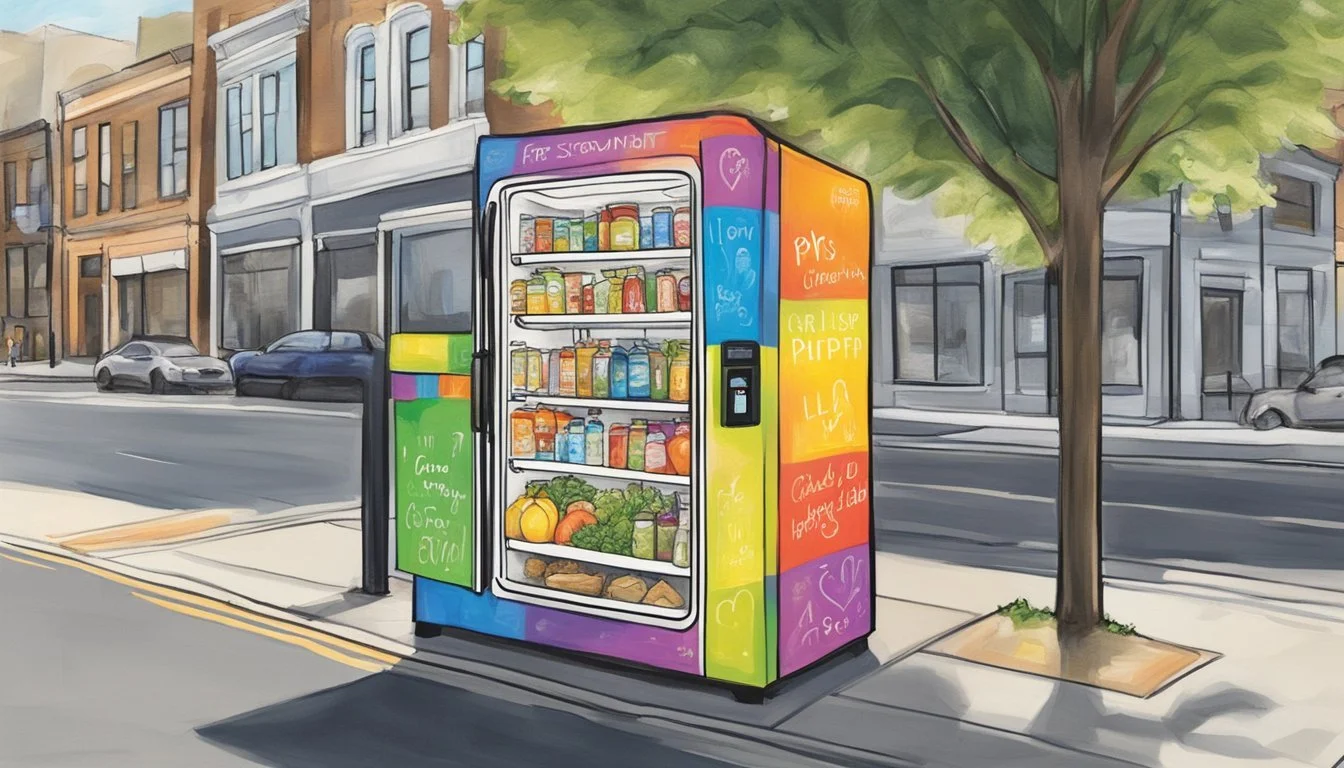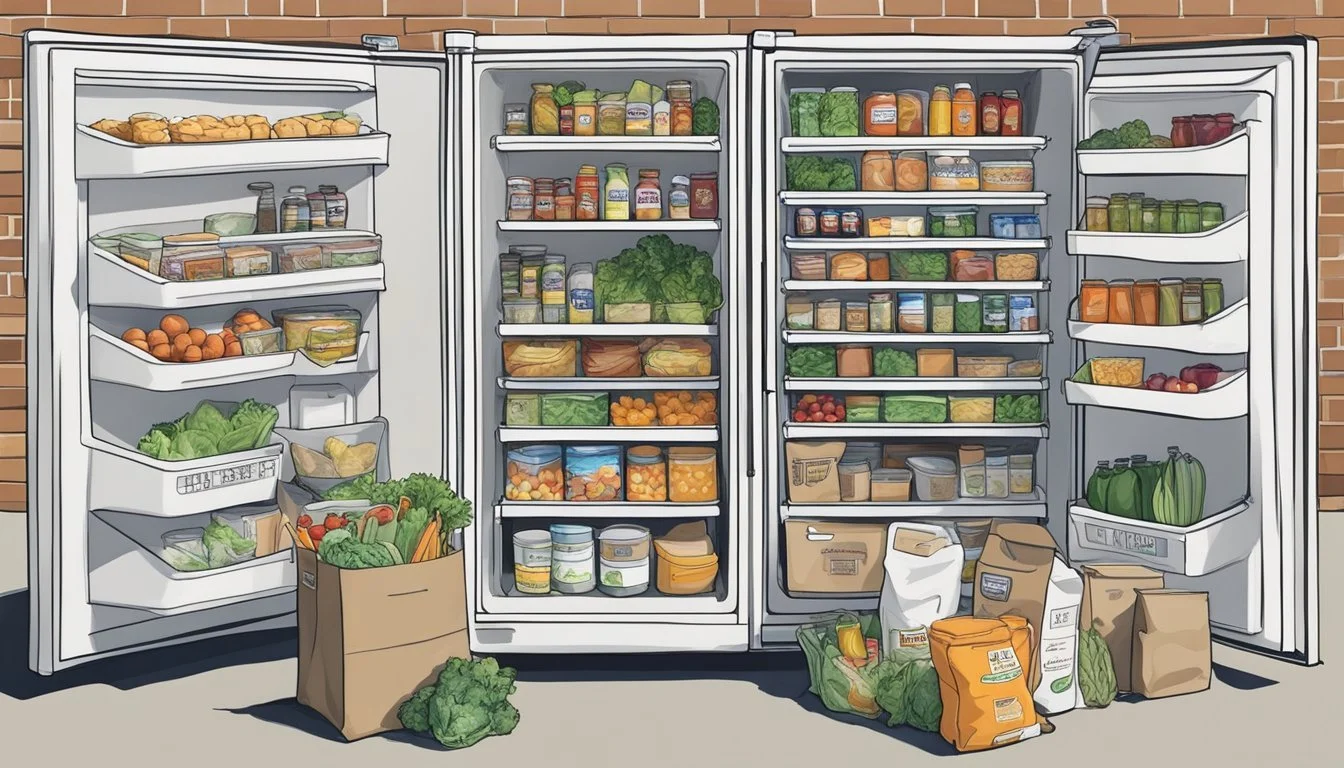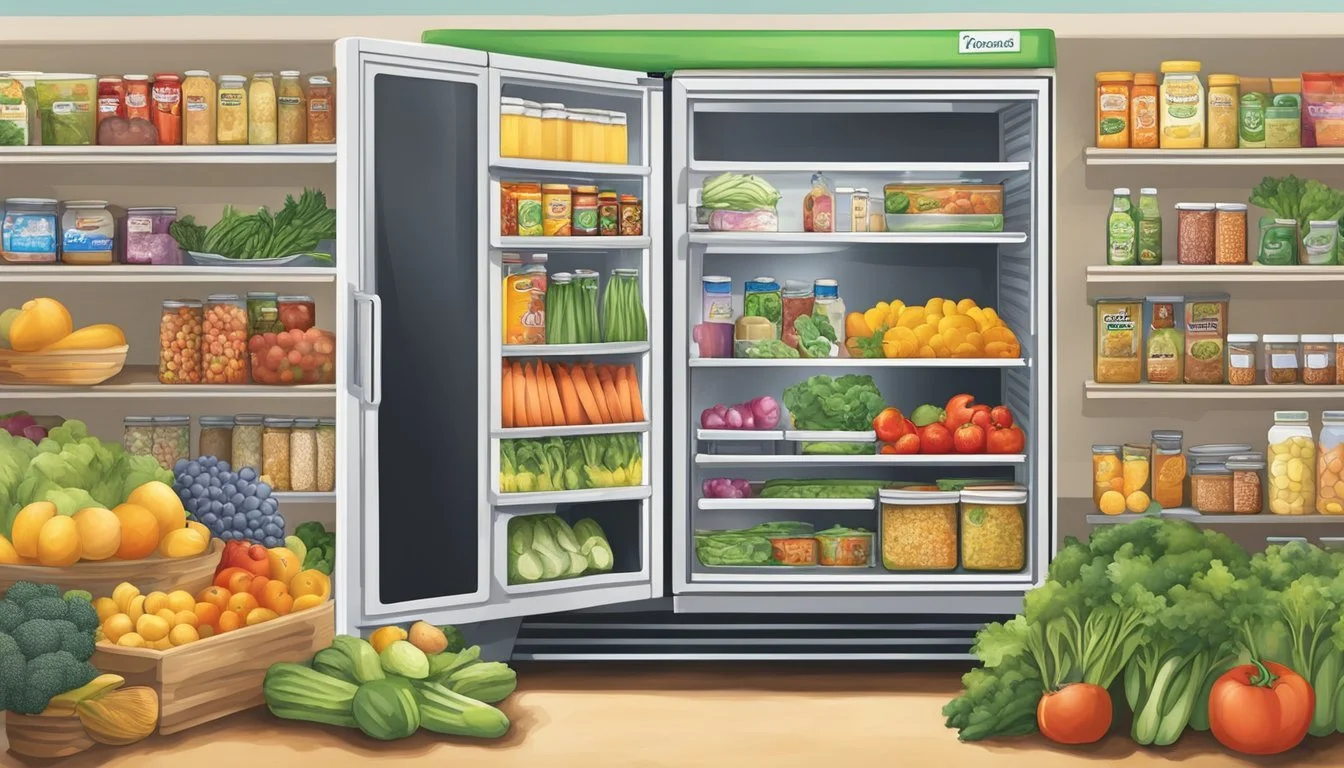Stamford, CT Community Fridge
Addressing Food Insecurity with Compassion
In Stamford, CT, the concept of community fridges offers a compelling approach to address food waste and food insecurity. A community fridge is a public refrigerator where residents and businesses can leave excess food for others to take freely and anonymously. This initiative embodies solidarity, allowing the local community to support one another while combating the issue of waste.
The Stamford Community Fridge operates on the simple premise that good food should not go to waste and that everyone has the right to have access to nutritious meals. It serves as a symbol of community spirit, providing a platform for residents to share resources. The fridge is open for contributions from anyone in the community, including local grocers, restaurants, and individuals. The shared responsibility reinforces a sense of community and offers a tangible expression of care and mutual support among citizens.
Situating such a project within the fabric of Stamford enables a diverse, urban populace to engage directly with issues of sustainability and food equity. The initiative not only strengthens community bonds but also promotes environmental consciousness by reducing food waste. As an easily accessible resource, the Stamford Community Fridge contributes to building a more inclusive and united city.
Community Fridge Concept
Community fridges are a growing trend that allow people to share surplus food and provide resources to those who are food insecure. They are a tangible example of community solidarity that directly tackles the issue of waste.
Definition of Community Fridge
A community fridge is a public refrigerator located in a communal space where individuals and businesses can donate surplus food and where those in need can access food freely and anonymously. The main premise is to reduce food waste while helping to address food insecurity.
History and Origin
The community fridge concept originated as part of the global food-sharing movement, with initiatives like solidarity fridges popping up in various countries. The Community Fridge Network, which supports the establishment and maintenance of such fridges, has helped in scaling the idea. In Stamford, Connecticut, the community fridge initiative began to gain traction as a means to support food-sharing efforts, with similar projects appearing statewide.
Goals and Benefits
The goals of community fridges include:
Reducing food waste by providing a place to share unused or surplus food.
Alleviating food insecurity by offering free access to nutritious food.
The benefits of a community fridge program are manifold:
Supports sustainability efforts by diverting waste from landfills.
Promotes social cohesion and community involvement by encouraging donations and volunteering.
Provides immediate and stigma-free food access for individuals who are struggling to afford groceries.
Stamford's Community Fridges
Stamford, CT, has embraced the concept of community fridges to combat food waste and provide for those in need. These fridges are stocked with food from local businesses and community members and are accessible to everyone.
Establishment in Stamford
The community fridges in Stamford were established as part of a broader initiative to offer fresh and nutritious food to residents facing food insecurity. This was particularly vital during the difficult times of the COVID-19 pandemic, and the movement received strong community support due to its positive impact.
Current Locations
Stamford's community fridges can be found in various accessible locations throughout the city. One such location, often referred to as Fridgeport after Bridgeport, signifies the community's role in the expansion and support of the network of community fridges. The exact locations are subject to change as the initiative grows and adapts to the community's needs.
Operational Model
Donations: Local businesses and residents donate food.
Volunteers: Community members manage and maintain the fridges.
Access: The fridges are available to the public 24/7, offering free food items without any restrictions or requirements.
Collaboration: The initiative operates through a collaboration between local organizations and businesses to ensure a regular supply of food items.
How Community Fridges Work
Community fridges in Stamford, CT operate as a nexus for free food distribution and food rescue, where individuals can participate in either donating to or retrieving food from these public resources. These refrigerators ensure that healthy food is available to the community, reducing waste and offering support to those in need.
Donation Process
Individuals and businesses can donate to the community fridge, contributing surplus or specifically purchased healthy food items. To maintain safety and quality, the donated items must meet specific criteria—sealed and labeled, with an understanding that perishable goods should have a reasonable shelf life remaining. The usual donation process is as follows:
Check Acceptable Foods: Review the guidance on what food items are appropriate for donation.
Prepare Donations: Ensure food is fresh, within use-by dates, and appropriately packaged.
Drop-Off: Donations are placed in the fridge during designated hours, or as directed by community fridge protocols.
Food Distribution
The food from community fridges is freely accessible to individuals who need it, without any formal check-in or verification process, promoting an ethos of trust and community support. Distribution mechanisms are typically straightforward:
Open Access: Fridges are available 24/7, so individuals can take what they need at any time.
Food Rescue: By taking food that would otherwise waste, they are participating in food rescue, contributing to environmental sustainability and community welfare.
These fridges act both as a recipient of food donations and a free food source for the community, embodying a successful model of communal support and sustainability.
Community Impact
The Community Fridge in Stamford, CT, serves as a beacon of hope for individuals facing food insecurity, embodying the principles of mutual aid and solidarity within the community.
Addressing Food Insecurity
The community fridge in Stamford actively combats hunger by providing residents with access to fresh, nutritious food at no cost. This initiative directly supports individuals and families who are food insecure, ensuring that surplus food reaches those in need instead of going to waste.
Promoting Mutual Aid
Through the establishment of the community fridge, the town of Stamford promotes a mutual aid network. This structure fosters a sense of community where residents support one another by contributing to and benefitting from the shared resource. It underscores the practice of solidarity rather than charity, encouraging community members to stand together in support of their neighbors.
Contributions to Social Services
Aligned with local social services, the community fridge offers a tangible solution to reduce food scarcity. By collaborating with businesses, non-profits, and social initiatives, the fridge not only helps to feed those in need but also raises awareness about the broader challenges associated with hunger. These efforts complement existing social services by providing an additional layer of support to their programs.
Supporting the Fridge Network
The success of the Stamford, CT Community Fridge relies on the commitment of volunteers and the generosity of donations. Local businesses and restaurants play a pivotal role in sustaining the network, ensuring it serves as a resource to alleviate food insecurity in the community.
Volunteer and Donation Opportunities
Volunteers are the backbone of the Community Fridge Network. They ensure the fridge is clean, organized, and well-stocked. Those interested in volunteering can sign up for various roles, from food sorting to fridge maintenance. Donations are crucial to the fridge's operation with guidelines in place to ensure food safety. Accepted items typically include:
Fresh produce
Packaged foods (unopened)
Bread and baked goods (from the day)
Monetary contributions are also essential, assisting with the fridge’s operational costs and the purchase of fresh goods from local sources.
Partnerships with Local Businesses and Restaurants
The network thrives through partnerships with local businesses and restaurants, which provide surplus foods that would otherwise go to waste. These collaborations are mutually beneficial; businesses reduce waste and profit loss, while the community gains access to a greater variety of nutritious foods. Mutual aid groups also join forces with the fridge project, amplifying the impact.
To support these efforts, businesses and restaurants can reach out to the Community Fridge Network to start a partnership. By doing so, they contribute to a sustainable model that addresses food apartheid and supports mutual aid projects within the Stamford area.
Risks and Challenges
Community fridges in Stamford, CT aim to address food insecurity with a spirit of solidarity, but with this approach comes inherent risks and challenges that must be carefully managed to ensure the project's success and sustainability.
Food Safety and Maintenance
Food safety is paramount for community fridges. Improper handling, storage, and maintenance can lead to foodborne illnesses which directly impact public health. Installers and volunteers must constantly monitor temperature control and adhere to food safety guidelines. A regular maintenance schedule is critical, which includes cleaning and promptly repairing any equipment malfunctions to mitigate health hazards.
Risk: Potential for food contamination and foodborne illnesses.
Repair: Essential for uninterrupted safe operations.
Sustainability Challenges
The sustainability of community fridges in a capitalist society is fraught with question marks. One must consider the long-term feasibility amid the constant need for resources. Financial and material waste poses a significant challenge.
Capital investment: Upfront costs for the fridge infrastructure.
Ongoing expenses: Recurrent costs for electricity, repair, and restocking.
Anti-waste efforts: Reducing food waste through efficient distribution.
Solidarity over competition: Maintaining community focus against competitive capitalist pressures can strain resources.
In summary, while community fridges like those in Stamford, CT, represent a beacon of hope for tackling food scarcity, they are not without their risks and challenges that require diligent oversight and community engagement.
Community Fridge Expansion
The expansion of community fridges in Stamford, CT reflects a growing commitment to reducing food waste and addressing food insecurity. These initiatives, often anchored by local organizations such as Kingdom Builders Impact Ministries, demonstrate effective collaboration and resource sharing among Stamford residents.
Future Projects
Kingdom Builders Impact Ministries, a cornerstone of the Stamford community fridge movement, continues to support and plan future projects. They aim to:
Expand the number of fridges throughout Stamford, increasing access to free food.
Promote sustainable practices by encouraging the community to share surplus food.
These projects not only enhance the community fridges network but also provide essential resources to residents in need, reinforcing food security.
Community Engagement Strategies
Community fridges thrive on active participation and involvement from local residents and groups. The following strategies have been pivotal in garnering community engagement:
Social Media Outreach: Using platforms like Instagram to update the community on fridge status and food availability.
Food Donation Campaigns: Encouraging local businesses and individuals to contribute, ensuring a continuous supply.
Volunteer Involvement: Volunteers are the backbone of maintaining and monitoring the fridges, as they help with stocking and clean-up.
Through these approaches, Stamford's community fridges have become beacons of mutual aid, fostering a shared responsibility and connection among individuals in the community.
Financial Aspects
The Community Fridge in Stamford, CT, represents a critical asset in addressing food insecurity by offering free food to residents. Funding and community support are pivotal for its operation.
Funding and Support
The Community Fridge initiative in Stamford operates largely on donations from the public, which contribute significantly to its sustainability. Financial support often comes through modern digital payment platforms like Venmo and CashApp, allowing donors to contribute easily and securely. These contributions help to maintain a steady supply of food items that are freely accessible to community members. Additionally, programs such as the USDA's Farmers to Families Food Box initiative may provide supplemental aid by sourcing and distributing agricultural products to support the cause.
Economic Impact on the Community
By providing free food through the Community Fridge, Stamford offers direct economic relief to individuals and families that are food insecure. This initiative helps stretch limited household budgets, fostering economic stability among recipients. It is more than a fridge; it's a financial buffer for those in need. Secondary economic effects include reduced food waste and strengthened community engagement, as local businesses and residents unify to address a shared social challenge.
Conclusion
The Stamford, CT Community Fridge is a testament to community spirit and solidarity. Located in Fairfield County, it provides a valuable resource for sharing food and reducing waste. Powered by the collective efforts of local residents, the fridge embodies the principle of mutual aid. Through such initiatives, Stamford encourages sustainable living practices and offers a supportive network to those in need.
Volunteers and social innovators play a critical role in the success of the Community Fridge. Their dedication ensures that the fridge remains stocked with good food, fostering a sense of togetherness. The project's open access policy—available 24 hours, seven days a week—highlights its commitment to inclusivity and community service.
Benefits to the Stamford Community:
Shared Resources: The fridge allows for the efficient distribution of food, ensuring that surplus items are not wasted but instead benefit community members.
Social Solidarity: It reinforces the bonds of community and provides a tangible way for residents to support one another through both contributions and withdrawals.
Environmental Impact: By reducing food waste, the Community Fridge contributes to environmental sustainability within Stamford.
Stamford’s Community Fridge serves as a model of community-driven solutions to food insecurity and environmental challenges. It underscores the city’s progressive and collaborative ethos. In future developments, sustaining the initiative will remain contingent upon ongoing community involvement and support.











